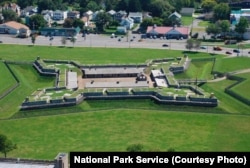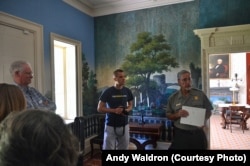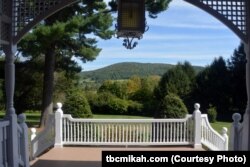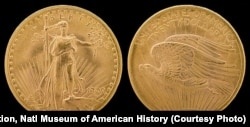In celebration of the National Park Service’s 100th anniversary, adventurer Mikah Meyer is traveling across America with the goal of visiting every one of the more than 400 sites within its jurisdiction.
The young traveler set out from Washington, D.C., in June and has already experienced dozens of sites. And VOA has been following him every step of the way.
Mikah Meyer spent much of September in the state of New York, where he visited several historic sites. He followed that with a quick trip to Vermont and a more leisurely visit to the home and studio of one of America’s greatest sculptors in the state of New Hampshire.
Symbol of Resistance
Fort Stanwix National Monument, a colonial fort in Rome, New York, was built by the British in 1758 during the French and Indian War, but had fallen into disuse by America's War of Independence in 1776.
Mikah said the most noteworthy fact about the fort is that it was never surrendered to the British.
“It never was controlled by the Brits, always by Americans,” he said.
“The site itself was used over a 100 plus year period; it actually was a downtown with buildings all over it up until the late 60s and 1969 when legislation was finally passed that allowed it to be rebuilt, to be reconstructed and turned into -- seven years later - the fort that we see today.”
Father of the Democratic Party
The Martin Van Buren National Historic Site, near Albany, New York, is the home and final resting place of America's eighth president.
Van Buren is considered the father of the Democratic Party since he played a major role in organizing it. He came from an old Dutch family and was the only president who spoke English as a second language.
Mikah said the site focused on the president’s history. Much of that history revolved around slavery, which in the early 1800s was a complicated issue. Like many Americans at the time, Van Buren thought it immoral, but permitted by the Constitution. He was against its abolition both in the District of Columbia and throughout the country, and said so in his Inaugural Address in 1837:
"I must go into the Presidential chair the inflexible and uncompromising opponent of every attempt on the part of Congress to abolish slavery in the District of Columbia against the wishes of the slave-holding States, and also with a determination equally decided to resist the slightest interference with it in the States where it exists."
Slavery would be abolished in the District of Columbia on April 18, 1862, during the Civil War. The 13th amendment, ratified at the end of 1865, marked the end of slavery throughout the United States.
History-making battle
Saratoga National Historical Park in the town of Stillwater, New York, is the site of two battles considered a turning point in the Revolutionary War. Here, in the autumn of 1777, American forces met, defeated and forced a major British army to surrender.
As an American, Mikah seemed very proud of that fact. He noted that this crucial American victory in the Battle of Saratoga brought France into the war on the side of the Americans.
It also renewed patriots’ hopes for independence, secured essential foreign recognition and support, and forever changed the face of the world.
Vermont’s only national park
At Marsh-Billings-Rockefeller National Historical Park in Woodstock, Vermont, Mikah was reminded that while we don't have royalty in America, we certainly do have “an oligarchy of wealthy individuals who are public and private in their philanthropies.”
The historic house and its surrounding property serve to honor several notable Americans who all once lived there and who used their great wealth to better the environment.
George Perkins Marsh, author of the influential book "Man and Nature," is considered by many to be the father of the American Conservation Movement.
Frederick Billings, a successful American lawyer, financier and president of the Northern Pacific Railway, was also known as a conservationist who would come to be closely associated with the development of the American West. He was heavily influenced by Marsh’s book, and used it to develop many of his ideas about forestry management. He put them into practice as a leading member of Vermont's Forestry Commission, which began reforestation projects in line with Billings' vision.
The last occupants of the house, Laurance Spelman Rockefeller and his wife, Mary French, Billings' granddaughter, donated the residential property, along with 225 hectares of Mount Tom forestland, to the National Park Service in 1992.
“We don't have Buckingham Palace in the United States,” Mikah said, “but it was interesting to see the way that a house - and the land around the house - inspired some wealthy philanthropists and businessmen in our country to all come to the same realization of wanting to help our environment."
American Renaissance
At the Augustus Saint-Gaudens National Historic Site, in Cornish, New Hampshire, Mikah enjoyed a respite from U.S. history by immersing himself in art.
Here, in the lovely home, studio and gardens of American sculptor Augustus Saint-Gaudens, he and other visitors were able to enjoy over 100 of Saint-Gaudens’s artworks; from heroic public monuments to expressive portrait reliefs, and the gold coins which changed the look of American coinage.
The most interesting thing about the site, Mikah noted, was that it’s New Hampshire's only National Park site.
“Just like Vermont, it only has one,” so he was impressed that the park service chose to honor an artist.
“We have so many monuments and sculptures to great Americans all across our country,” he said, “but nobody ever thinks about who made that sculpture and as an artist myself, I appreciated that they were recognizing the artist.”
There’s a house on the property, a garden with large sculptures, a small gallery and a barn, which was one of his studios. "They’ve kept it to look if he was working on a piece of sculpture," Mikah explained, “molding the plaster as if he was getting ready to send it off to be bronzed.”
Current and Coming attractions
Mikah is continuing his journey north with a recent hike along the northern end of the Appalachian National Scenic Trail at the peak of Mount Katahdin and the newly-established Katahdin Woods and Waters National Monument, both in the New England state of Maine.
Follow Mikah
To follow Mikah and learn more about the places where he’s traveling, visit his website for more details.













